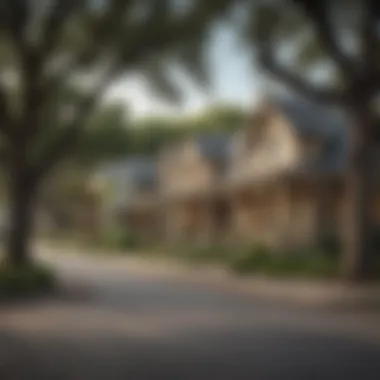Explore the Best Places to Live in San Antonio, TX


Intro
San Antonio, Texas, is a city characterized by its unique blend of history, culture, and diversity. As many potential residents seek a place to call home, understanding the various neighborhoods becomes essential. This guide delves into the city’s neighborhoods, offering an insightful look into what each area contributes. By examining aspects such as social dynamics, economic opportunities, and cultural amenities, individuals can make informed decisions that align with their lifestyle.
The areas that will be explored range from the centrally located urban districts to the peaceful suburbs. Each neighborhood has its own identity and advantages, making San Antonio a place where everyone can find a suitable home. Whether you are an art enthusiast drawn to vibrant city life or a family-oriented individual looking for tranquility, this guide will provide the necessary information to navigate through your options.
Home Design Inspiration
San Antonio's architectural landscape is as varied as its demographic composition. The buildings reflect a fusion of traditional and modern styles, offering inspiration for homeowners and renters alike.
Architectural Styles
When considering where to live, the architectural appeal of a neighborhood can significantly impact your overall experience. Here are some notable styles you can find in San Antonio:
- Spanish Colonial Revival: This style is prevalent in many historic neighborhoods, characterized by stucco walls, red tile roofs, and wrought-iron details.
- Craftsman Bungalows: These homes provide charm and warmth, often featuring exposed beams and built-in furniture.
- Mid-Century Modern: An increasingly popular choice, these homes focus on clean lines and functional space, blending indoor and outdoor living.
Innovative Decor Trends
In addition to the architectural styles, the decor trends that are shaping homes in San Antonio are quite significant. Many residents prefer incorporating natural elements into their interior design. This includes:
- Sustainable Materials: Eco-friendly materials are trending, emphasizing the importance of environmental consciousness.
- Multi-Functional Spaces: With remote work becoming more common, the demand for adaptable living spaces has increased.
- Local Art: Homeowners are showcasing works from local artists, supporting the area's vibrant art community while enhancing their interiors.
These design inspirations reflect the overall culture of San Antonio, blending heritage with modern living. By understanding these aspects, prospective residents can envision how their lifestyle and personal style align with the neighborhoods in the area.
Overview of San Antonio
San Antonio, Texas is a city woven into the fabric of American history and culture. Understanding the city’s essence is crucial for anyone contemplating a move here. This section provides context on the historical, demographic, and economic aspects, enriching the decision-making process when selecting a neighborhood to call home.
Historical Context
San Antonio's history is rooted in a rich tapestry that spans centuries. Founded in 1718, it has evolved from a Spanish mission to a significant military post. The Alamo, a pivotal site in the Texas Revolution, anchors the city’s historical identity. Its past influences modern culture, seen in the vibrant festivals and annual events that honor its heritage. This backdrop allows residents to feel connected to their surroundings and provides a deeper appreciation for the city's evolution.
Demographic Profile
The demographic profile of San Antonio reveals a melting pot of cultures and backgrounds. With a population exceeding 1.5 million, the city ranks among the most populous in the United States. The diversity is reflected in the neighborhoods, each offering unique perspectives and experiences. About 63% of the residents identify as Hispanic or Latino, which shapes the city’s cultural landscape. The median age is around 34 years, attracting families, young professionals, and retirees alike. This diverse demographic contributes to an inclusive atmosphere, which is appealing to many potential residents.
Economic Landscape
San Antonio's economy displays a dynamic mix of industries, making it an attractive destination for job seekers. The military presence is significant, with several bases contributing heavily to local employment. The city also boasts a burgeoning healthcare sector, represented by major institutions like the University Health System. Tourism flourishes, leveraging historical sites and annual events to attract visitors. Moreover, the tech industry is growing, offering new opportunities for professionals. This economic variety ensures the city remains resilient and adaptable, thus enhancing the appeal for those considering relocation.
Factors to Consider When Choosing a Neighborhood
Choosing the right neighborhood in San Antonio is a decision that requires careful consideration. This city, known for its rich culture and vibrant community, offers a variety of living spaces, each with its unique character. Factors that influence this decision can greatly impact daily life, long-term satisfaction, and financial investments. A thoughtful approach to selecting a neighborhood is essential for prospective residents.
Accessibility and Transportation
Accessibility is a key factor in determining a neighborhood's suitability. San Antonio has a mix of public and private transportation options that facilitate commuting within the city and to surrounding areas. The VIA Metropolitan Transit operates buses throughout the city, offering a reliable means of transport for those without a personal vehicle. Furthermore, major highways such as I-10 and I-35 ensure that residents can easily travel to other regions, making commutes less burdensome.
Proximity to essential services, such as grocery stores, hospitals, and schools, enhances the accessibility of a neighborhood. If the area lacks public transportation, long driving distances may become inconvenient. Therefore, potential residents should evaluate both the transportation options available and the overall infrastructure of the neighborhood.
Educational Institutions
The quality of educational institutions is a critical consideration, especially for families. San Antonio hosts a range of public and private schools, as well as higher education options like The University of Texas at San Antonio and Trinity University. Neighborhoods such as Alamo Heights and Stone Oak are known for their strong public school systems, making them appealing to families prioritizing education.
Additionally, access to educational facilities can affect property values. Areas with highly-rated schools often see a demand that boosts home prices. Understanding how local schools rank and their performance metrics can inform decisions on where to live.
Safety and Crime Rates
Safety is paramount when choosing a neighborhood. Each area in San Antonio has distinct crime patterns and statistics. Various resources, including neighborhood watch programs and local police reports, provide insights into safety levels. Areas with lower crime rates tend to attract families and those looking for peace of mind.
Furthermore, a neighborhood’s safety reputation can impact property values. Homes in safer areas generally retain their value better than those in neighborhoods known for crime issues. Thus, it's crucial to research crime trends and local law enforcement engagement in the area of interest to gauge the overall safety and community well-being.
Community Amenities
Amenities can serve as a deciding factor for many individuals when selecting a neighborhood. San Antonio presents a wealth of options, from parks and recreational facilities to shopping centers and cultural institutions. Neighborhoods like The Dominion are known for their exclusive, high-end amenities, while areas such as Southtown emphasize local art and community events.
Access to community amenities enriches residents' lives and enhances social interaction. Those looking for vibrant neighborhoods with a strong sense of community will benefit from understanding the available amenities before making a move. Families may seek parks and sports facilities, while young professionals may prioritize nightlife and dining options.


Popular Neighborhoods in San Antonio
Understanding the neighborhoods in San Antonio is vital for anyone considering a move to the city. Each area has its own unique character, and knowing what they offer can help potential residents make informed choices. The neighborhoods vary widely in terms of real estate pricing, cultural offerings, and community engagement.
This section explores several popular neighborhoods in San Antonio, detailing their key attributes and advantages. From upscale areas with luxury amenities to vibrant urban locales, these neighborhoods cater to diverse lifestyles and preferences.
Alamo Heights
Real Estate Market Overview
Alamo Heights boasts a notable real estate market characterized by high property values and demand. The area has a range of homes, from historic estates to modern constructions. The housing market here is competitive, which makes it appealing to affluent buyers looking for prime locations.
One key characteristic of Alamo Heights is its excellent investment potential. The appreciation rate of properties is significantly higher than the city average, contributing to its desirability. However, the downside can be the higher cost of entry, which may not suit every budget, particularly for first-time homebuyers.
Local Attractions
Alamo Heights is home to several local attractions that enhance its appeal. This includes cultural landmarks such as the San Antonio Museum of Art and the nearby McNay Art Museum. These venues not only offer artistic stimulation but also contribute to a vibrant community culture.
Additionally, the neighborhood has beautiful parks and quaint shopping districts, making it a sought-after area for leisure and recreation. The blend of attractions serves as a significant advantage, though some may find the area less dynamic than more commercial neighborhoods.
Community Vibe
The community vibe in Alamo Heights is often described as welcoming and close-knit. Residents enjoy a strong sense of belonging and active neighborhood associations. This characteristic fosters engagement in local events and initiatives, allowing citizens to shape their living environment.
The community’s affluence might result in a diverse mixture of people, yet it can sometimes create exclusivity. Potential residents interested in community cohesion may find this aspect worth considering.
Stone Oak
Park and Recreational Facilities
Stone Oak is well-regarded for its extensive park and recreational facilities. The area features numerous green spaces, including the popular Stone Oak Park, which offers trails, playgrounds, and picnic areas. These amenities are essential for families and active individuals who prioritize outdoor activities.
The accessibility of parks can be a significant advantage for daily leisure and social gatherings. However, during peak times, these facilities can become overcrowded, which may detract from the experience.
Schools and Education
The education options in Stone Oak are impressive. The neighborhood is served by highly-rated public schools, such as the Northside Independent School District. Schools in this area often receive accolades for their academic performance, making it a wise choice for families with children.
The quality of schooling here is a crucial factor for many potential residents, contributing positively to property values. While some parents might feel pressure from the competitive nature of admissions, this can motivate students to succeed.
Demographic Insights
Demographically, Stone Oak is known for its diversity and family-oriented community. The area attracts a mix of young professionals, families, and retirees, creating a vibrant social atmosphere.
This demographic variety can lead to enriching social interactions, yet it may also result in occasional challenges in maintaining community standards due to varying expectations among residents.
The Dominion
Luxury Living
The Dominion stands out as San Antonio's premier luxury neighborhood. Known for its opulent homes and exclusive gated communities, it offers an upscale lifestyle that few areas can match. Residents can enjoy privacy and top-tier amenities, which enhances the overall living experience.
Luxury living involves higher housing costs but also access to high-quality services and security, adding value for those who prioritize such features. However, the exclusivity and price point may be off-putting for some potential residents.
Exclusive Amenities
Residents of The Dominion benefit from exclusive amenities, such as private golf courses and tennis courts. Upscale shopping and fine dining are also easily accessible, which enhances the luxury lifestyle. These amenities provide a level of convenience that is attractive to affluent buyers.
Nevertheless, the cost associated with such privileges may be a disadvantage for anyone not prepared to invest significantly in their lifestyle.
Cultural Influence
Culturally, The Dominion reflects an influence of affluence and refinement. The neighborhood often hosts upscale events and functions that draw in high-profile guests and residents. The cultural landscape can facilitate networking opportunities and a sense of belonging in a sophisticated environment.
While the cultural advantages can enhance the living experience, it can create a divide between wealth levels and potentially alienate those looking for a more community-driven environment.
Downtown San Antonio
Urban Lifestyle


Living in Downtown San Antonio provides a unique urban lifestyle characterized by a blend of excitement and culture. With its bustling streets and diverse population, residents enjoy easy access to shopping, dining, and nightlife. The urban environment encourages a dynamic lifestyle that appeals to many.
However, the fast pace may not suit everyone, and some residents may find it challenging to adapt to the noise and crowd, which can be a drawback.
Business Hub
Downtown serves as a business hub, with numerous offices, corporations, and co-working spaces. This makes it a practical choice for professionals looking to minimize their commute. The convergence of economic activity in the area supports a thriving local economy.
While there are many opportunities for career advancement, the fast-paced work environment can sometimes create stress for those unaccustomed to it.
Historical Significance
The area's historical significance adds another layer of appeal. With landmarks such as the Alamo and various museums, residents have a wealth of cultural history at their doorstep. This aspect enriches the living experience and allows for a deeper appreciation of the city's heritage.
Yet, the focus on tourism can sometimes detract from the sense of community, making it feel less personal than other neighborhoods.
Hill Country Village
Rural Charm
Hill Country Village offers a unique rural charm that contrasts with the nearby urban sprawl. The area features tree-lined streets and spacious lots, appealing to individuals and families looking for a serene living environment.
This characteristic promotes a slower, more relaxed lifestyle and can offer a welcome respite from city life. However, the rural aspect may not include as many urban conveniences, which could be a drawback.
Community Events
Community events are a hallmark of Hill Country Village. From seasonal festivals to neighborhood gatherings, residents have many opportunities to connect and engage. These events enhance the community spirit and foster relationships among neighbors.
While the tight-knit community is a significant advantage, it may also emphasize certain social expectations that some may find limiting.
Real Estate Overview
The real estate market in Hill Country Village is characterized by spacious homes and low density, promoting privacy. Housing costs are moderate compared to nearby luxury areas, making it an appealing option for buyers looking for value.
However, fewer properties might be available, which can limit choices for potential new residents.
Terrell Hills
Art and Culture
Terrell Hills is known for its vibrant art scene and cultural offerings. Local galleries and studios often showcase work from both emerging and established artists. This focus on art enhances the neighborhood's appeal, particularly for those who appreciate cultural expression.
While the emphasis on art adds vibrancy to the community, it may also lead to competition among artists and galleries, which could affect independent creators.
Residential Appeal
The residential appeal of Terrell Hills stems from its quiet, suburban atmosphere, which is particularly attractive to families and professionals alike. Tree-lined streets and well-kept homes contribute to a peaceful living environment.
This tranquility is a significant advantage for those seeking a respite from more bustling areas, but for some, it might feel too isolated or slow-paced.
Local Governance
Local governance in Terrell Hills is proactive and engaged, often involving residents in decision-making processes. This practice fosters a strong sense of community ownership and accountability. The ability to influence local policies can lead to positive changes in the neighborhood.
However, some residents may find local governance discussions too involved for their tastes, leading to a desire for a more hands-off approach in their community affairs.
Emerging Areas in San Antonio
Emerging areas in San Antonio are noteworthy for those seeking a fresh perspective on their living environment. These regions often blend old charm with modern vibrancy, offering residents opportunities to be part of evolving communities. As urban development continues, these neighborhoods present unique lifestyle options that can suit various preferences.
Southtown
Southtown is a district renowned for its artistic flair and cultural richness. It has transformed into a hub for creative expression. The area's art scene is marked by numerous galleries showcasing local talent, making it a well-regarded community for artists and art lovers alike.
Art Scene
The art scene in Southtown is a significant draw for residents and visitors. This area features numerous art installations, galleries, and events celebrating creativity. The key characteristic here is its vibrant atmosphere that fosters community and collaboration. Art walks and festivals occur regularly, contributing to the community's engagement. One unique feature is the First Friday Art Trail, where galleries open their doors for the public to explore.
Advantages of living in Southtown include easy access to cultural events and a strong sense of community among artists. However, some may find the increase in tourism and foot traffic overwhelming at times.


Gastronomy
The gastronomy in Southtown complements its art scene. This neighborhood boasts a rich variety of restaurants and cafes, serving cuisines from around the world. An important aspect is its emphasis on locally sourced ingredients. This supports the community’s economy while delivering high-quality food.
Unique features include the vibrant food markets that pop up frequently, offering everything from gourmet meals to local snacks. With a plethora of dining options, residents enjoy a culinary adventure within walking distance.
This array of gastronomy enhances the overall living experience. The only downside is that popular spots can get crowded during peak hours.
Community Development
Community development in Southtown focuses on improvement and growth while maintaining its artistic charm. Recent initiatives aim to support local businesses and enhance public spaces. A key characteristic is the balance between modern infrastructure and preserving historical sites.
Community engagement is notably strong here, with residents actively participating in town hall meetings and initiatives that affect the area. This vibrant neighborhood becomes inviting for those who value community involvement.
While development brings benefits like increased property value, there can be challenges. Gentrification may displace long-time residents, posing a concern for genuine community cohesion.
Eastside
Eastside emerges as another vibrant area with a unique character and potential for growth. It has historical significance and continues to evolve with gentrification and community efforts.
Gentrification Trends
Gentrification trends in Eastside carry both opportunities and challenges. This area sees new developments that often improve infrastructure and services, attracting a diverse population. The key characteristic is the shifting demographics, offering a mix of old and new residents.
Gentrification enhances property values, which can interest real estate investors. However, it is vital to consider its impact on long-standing community members who might be displaced due to rising costs.
Historical Context
The historical context of Eastside adds depth to its identity. With a rich cultural history, this area is a tapestry of traditions and stories. Its historical significance lies in its role in shaping San Antonio's cultural landscape, making it attractive for those interested in heritage.
Unique features include landmarks that reflect the community's history, such as churches and community centers. This aspect contributes to a strong sense of place for residents and tourists alike, enhancing the appeal of living in this area.
Nevertheless, it is crucial to blend history with modern needs to ensure that the community evolves without losing its identity.
Community Initiatives
Community initiatives in Eastside focus on fostering collaboration and inclusivity. Programs often aim to bridge gaps between new and existing residents, emphasizing mutual respect and understanding. A notable characteristic is grassroots activism, with many residents advocating for equitable development.
These initiatives can lead to enhanced amenities and improved quality of life for everyone. They also encourage relationships among neighbors, fostering a respectful community environment. However, differing perspectives may occasionally lead to conflicts.
Eastside and Southtown represent vibrant examples of areas redefining the essence of living in San Antonio. Through art, gastronomy, and community initiatives, they invite residents to consider not just the living conditions, but the overall quality of life.
Economic Considerations
Economic considerations play a crucial role in decision-making for individuals and families looking to relocate. San Antonio, Texas, presents a unique blend of factors that can influence where you might choose to live. Understanding the economic landscape allows potential residents to align their housing decisions with financial realities.
Housing Affordability
San Antonio stands out regarding housing affordability. With a cost of living lower than the national average, many find the housing market more accessible. This is particularly appealing for first-time homebuyers, professionals, and families seeking spacious homes at reasonable prices. The median home price in San Antonio is notably lower than in other Texas cities such as Austin or Dallas. This affordability extends beyond home purchases, influencing rental prices as well.
Potential residents should also consider neighborhood variances. Areas like Alamo Heights or The Dominion may command higher prices due to their amenities and reputation, whereas neighborhoods like Southtown often present affordable options without sacrificing character or community support. The overall trend in San Antonio suggests a robust market for both buyers and renters, offering diverse options.
"Economic factors, particularly housing affordability, serve as a primary guideline for potential residents, ensuring that choice aligns with their financial capabilities."
Job Market Trends
The job market in San Antonio is another vital factor. The city has experienced consistent growth in employment across sectors like healthcare, education, and technology. Companies such as USAA and Valero Energy have established a significant presence here, creating thousands of jobs. The expansion of these industries often influences migration patterns. People look for residence in regions where they expect job stability and growth.
The unemployment rate in San Antonio tends to remain lower than the national average, providing a sense of job security and stability. This is particularly crucial for new residents who weigh their career prospects against their living costs. Furthermore, as the city invests in infrastructure and community development, job opportunities are expected to grow, making San Antonio increasingly attractive for new movers.
In summary, the economic considerations regarding housing affordability and job market trends are deeply interconnected. Understanding these aspects provides a clearer picture of what living in San Antonio entails, aiding in making informed decisions.
Culmination and Final Thoughts
In the quest to find a suitable living space, understanding the various neighborhoods in San Antonio is essential. This guide sheds light on the diversity of options available, which cater to different lifestyles and preferences. By examining economic factors, community amenities, and local culture, potential residents can formulate a more informed perspective about where they might thrive best.
One of the key aspects to consider is what each neighborhood uniquely offers. For instance, areas like Alamo Heights are known for their upscale residences and cultural highlights. On the other hand, neighborhoods such as Southtown present dynamic creative scenes and culinary ventures. Recognizing these distinctions helps individuals align their lifestyle choices with the right environment.
When evaluating potential homes, economic considerations are paramount. Housing affordability influences many decisions in San Antonio, where some neighborhoods present more accessible market conditions than others. Understanding job market trends also helps gauge long-term viability in various locations, complementing the overall decision-making process.
"Your home is more than a place; it shapes your experience in the city. The right neighborhood can significantly improve your quality of life."
Altogether, this comprehensive guide focuses on providing relevant details to facilitate a smooth transition for anyone looking to relocate to San Antonio. Ultimately, the insights presented in this article empower individuals to move beyond superficial choices. They can base their decisions on a blend of personal preferences, community attributes, and economic realities.
Embracing these considerations allows potential residents to embark on their new journey in San Antonio with confidence and clarity.







